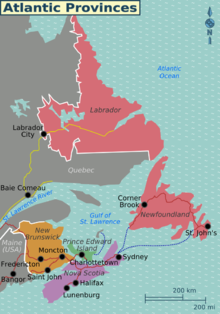Atlantic Canadian English
English was first spoken in Canada in the 17th century in seasonal fishing communities along the Atlantic coast, including the island of Newfoundland, and at fur trade posts around Hudson Bay.
[3] Distinctive regional settlement histories have also created several smaller, less broadly recognized speech enclaves within Canada, which likewise challenge the notion of a unified Canadian English, if not as starkly as the case of Newfoundland.
Today, these are found mostly in Nova Scotia, where they include Cape Breton Island (the northern part of Nova Scotia), settled mostly by Scottish Highlanders; Pictou County, a second centre of Highland Scots settlement on the mainland; Lunenburg, a town on the south shore settled largely by Germans; and an African-Canadian community, dispersed among several locations, made up of descendants of the servants who accompanied Loyalist immigrants and of refugees from American slavery.
That is strongly true in Nova Scotia's Sydney English specifically, which also features a merger of /æɡ/ and /eɪɡ/ (making haggle sound like Hagel).
The varied but similar Maritimer accents are influenced by an overwhelming majority of early Scottish and Irish immigration namely in the regions of Saint John, Miramichi, Cape Breton and parts of Halifax.
In addition to the above, the English of the Maritime Provinces (New Brunswick, Nova Scotia, and Prince Edward Island) has some unique phonological features: The interrogative "right?"
"[2][pages needed] Prince Edward Islanders use more British terms more often than any other Maritimers because of the overwhelming homogeneity of the province's Scottish and Irish ethnicity.
This is due to the long withstanding history of its colonization and settlement by both France and Britain, as well as the continuation of the French language which was sanctioned by the ruling British authorities at the time.
However, it was not until a wave of 35,000 Loyalists[14] arrived in New Brunswick in 1783 that cemented a substantive English-speaking community, combined with the francophones in creating a larger population, which enabled it to become its own province.
[14] In New Brunswick, the combination of typical standardized toppings at Canadian pizzerias that includes pepperoni sausage, mushroom, green pepper, tomato sauce, and cheese is referred to as "the works".
Additionally, where the term "notebook"is used to describe lined paper that is bound together, in the Maritimes, the type 1 Canadianism scribbler takes over.
[14] The distinct regional differences have led to the creation of less widely recognised speech enclaves in Canada: Nova Scotia, which includes Cape Breton Island (the northern part of Nova Scotia), settled mostly by Scottish Highlanders; Pictou County, a second centre of Highland Scots settlement on the mainland; Lunenburg, a town on the south shore settled largely by Germans; and an African-Canadian community, dispersed among several locations, made up of descendants of the servants who accompanied Loyalist immigrants and of refugees from American slavery.
[16] The town of Lunenberg, in particular, has been a huge influence in Nova Scotia English; its dialect traditionally includes the familiar "all" for "all gone", and a final "ain't" as a request for confirmation.
The Lunenberg dialect today is very much like that of the surrounding region along the South Shore of Nova Scotia and bears far greater resemblance to the Yankee New England speech likely spoken by the early planters.
[citation needed] Outside of the treatment of /r/, South Shore speech shares many similarities with other parts of the Maritimes owing to its (indirect) English ancestry throughout Atlantic Canada.
Scoff (DPEIE Page 126) n. — Prince Edward Island, A big meal, often of seafood or other seasonal food and in connection with a party.
— Prince Edward Island, Of the sea, covered with a dense, slushy, mass of ice fragments, snow, and freezing water.
[24] In the eighteenth century there was a divide between the small managerial class, which consisted of English merchants and agents from Devon, Dorset, and neighboring counties and laborers, most of which were Irish.
[25] The 19th century provided a model of educated and cultural English and Anglo-Irish speech due to the governor becoming the focus of a small elite circle in the capital city of St. John's that included naval officers, principal merchants, clergymen, doctors, officials, and a steady stream of educated visitors and scientists.
[25] Researchers find it difficult to identify specific Canadian pronunciations, intonations, grammatical forms, idioms, or regional vocabulary brought from other provinces to Newfoundland before 1949.
During World War II many Newfoundland brides were brought home by American soldiers and consequently close familial ties in both countries.
7. mummering mumming (DCHP-2 October 2016) n. — also attributively, Newfoundland, Social customs the practice of visiting houses in elaborate costumes and disguises, participating in various group activities over Christmas.

